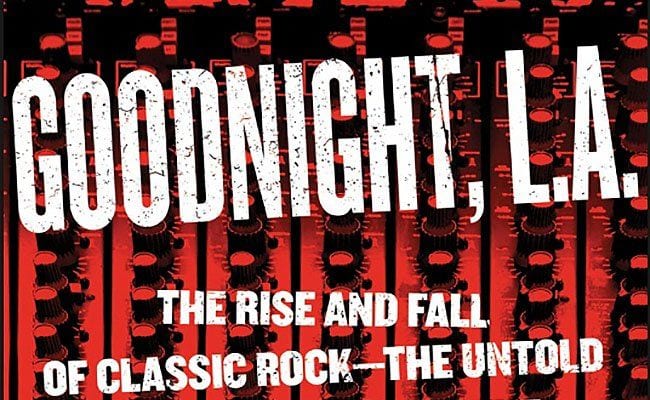
Kent Hartman once wrote an awesome book about the Wrecking Crew, a handful of first call studio session musicians who quietly upped the ante for many of the best songs in the ’60s and ’70s. He’s really good at discussing the stories of classic rock’s unsung heroes. His new book, Goodnight, L.A.: The Rise and Fall of Classic Rock — The Untold Story from inside the Legendary Recording Studios, attempts a repeat of his strong suit, this time zooming in on two particularly noteworthy dudes who are often heard but seldom recognized: Keith Olsen and Waddy Wachtel. This famed producer and smoking hot guitarist where inside most of the recording studios where the legends of classic rock rose and fell.
The beginning few chapters of the book keep a tight focus on these two underdogs as they make their way to Los Angeles seeking fame and fortune that eluded them early on elsewhere. Hartman successfully weaves a tapestry of their two lives in and out of studio time in order to paint a portrait of all the classic rock goings on in the ’70s and then on into its death throes in the ’80s and last gasp in the ’90s. Readers come away with a strong sense of each player’s power, as well as the arc of many bands’ long and storied careers. Rick Springfield, Fleetwood Mac, the Grateful Dead, Pat Benatar, Santana, Tom Petty, Foreigner, Journey, Boston — you name it, at least one of these two guys was there when the magic happened.
What the author doesn’t do is effectively capture who those two key characters really are, except by their most self-evident attributes of tinkerer and straight-shooting string man. For leading roles in this story, their personalities tend toward the one-dimensional. What Hartman lacks in character development, however, he makes up for with an almost filmic interpretation of the events. With flatly accessible characterization, the author uses his keen sense of Hollywood styling and focuses on the action, including attendant cliffhangers at the end of each chapter. The result is a great deal of suspense manufactured somewhat artificially. We know the Titanic sinks.
The story opens with The Beach Boys and Charles Manson at Sound City in early 1969. It closes with the birth of Nirvana and the rise of MTV music videos. In between, there’s a great deal about Fleetwood Mac, Chicago, and the Eagles. There are also sizeable treatments of Tom Petty, Santana, Pat Benatar, and Linda Ronstadt. There are detours into Boston and Foreigner. The story expands and contracts around these players, but again never quite fleshes out their characters, instead reducing dynamic individuals like Stevie Nicks to her naïve and witchy basics. The subtitle of the book promises an “untold story”, but most of Hartman’s interviews with the people who were inside these legendary recording studios offers mostly the same rehashed sound bites and mythical adventures that have been repeated about these events for years.
Admittedly, to collect them all in one place and weave a cohesive narrative out of them is a valuable endeavor. The Sound City documentary, by contrast, seems to offer a lot more earnestness and tighter focus on personalities. And yet, there’s still something charming about the author’s version of these same events. My mother does not read very much nonfiction, but since all her favorite musicians are represented here, I think she might really like Goodnight, L.A.. It’s not quite a novelization of events, because of its weak character development, but Hartman’s understanding of the interconnectedness of the scene and the events of the classic rock era make this a worthwhile contribution to the storytelling historians do about that era.
Hartman does not seriously theorize any reason why the era of classic rock ultimately came to an end. He spends some time on MTV and on the various backlashes of disco, punk, new wave, and grunge. The epilogue is sure to note that Keith Olsen and Waddy Wachtel are still crushing it, but they simply are not rising to the top of the charts like they used to. Hartman has succeeded in building a cohesive narrative of the events of the ’70s, but offers little evaluation of how the rise and fall took place, and little inside information in the way of new facts. He’s flattened the whole thing into a solid Hollywood unit. The movie version of this book would hover easily over the vicinity of shows like the failed Vinyl on HBO.
It’s pretty hard to build a book around someone’s career when, according to the back matter, the author has only interviewed him for one day. Waddy Wachtel may have gotten short shrift; it could have been wiser to simply do a biography of Keith Olsen, but then Hartman would be excluding a couple of key moments he clearly wants to discuss. Hartman’s book is like an all-in-one kitchen appliance, doing too many things sort of well, instead of trying to do one thing perfectly.


![Call for Papers: All Things Reconsidered [MUSIC] May-August 2024](https://www.popmatters.com/wp-content/uploads/2024/04/all-things-reconsidered-call-music-may-2024-720x380.jpg)



